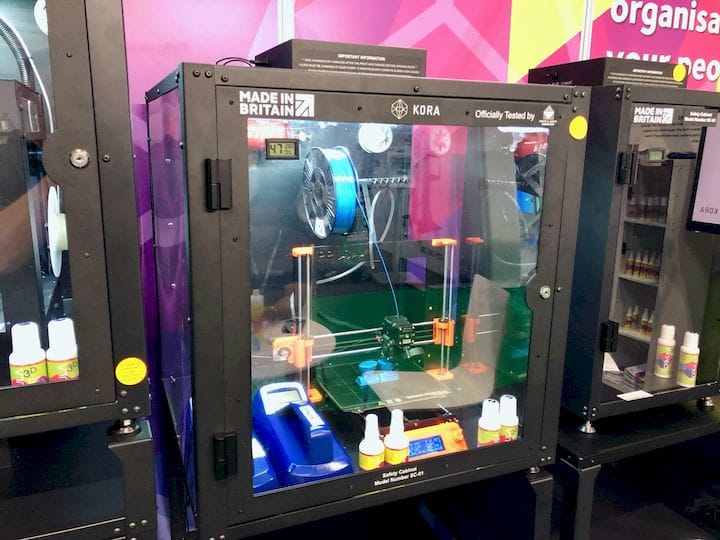![The Kora SC-01 Safety Cabinet [Source: Fabbaloo]](https://fabbaloo.com/wp-content/uploads/2020/05/image-asset_img_5eb08f44ecbbf.jpg)
I had a chat with the friendly folks from Kora, a UK-based manufacturer of 3D printer enclosures.
3D Print Enclosures
By “enclosure”, I don’t mean a specialized case intended to capture heat and improve print quality, although I suspect Kora’s products actually do that too. No, I mean they have built a specialized container into which an entire 3D printer is placed for safety purposes.
Kora is originally a car parts manufacturer that started in 2013 using 3D printers made by others. In a repeat of the classic 3D printer origin story, Kora found these to be inadequate for their purposes and decided to make their own 3D printer, which they still market.
But it seems since then they’ve begun focusing strongly on a safety enclosure, and I think that’s a very good idea.
3D Printing Safety
3D printer safety is a topic most often ignored by manufacturers, buyers and operators, yet it is still a thing to be dealt with.
There are several failure modes that most 3D printers are subject to:
-
Emission of nanoparticles from heated thermoplastics that can be inhaled and cause long-term health issues
-
Mechanical trapping of curious fingers if placed within the motion system of a 3D printer
-
Burnt fingers or other body parts if touching hot end nozzles, which can now be as high as 450C
-
Risk of fire due to wiring issues and lack of or failing of the thermal runaway circuits
None of these are good scenarios, and the first one, nanoparticle emissions could very well be happening on many 3D printers today simply because it is not particularly visible and happens over the long term.
UK 3D Printer Safety
In the UK, the Health and Safety Commission made recommendations about such safety concerns to higher education institutions, where they are now becoming much more aware of the issues. In the past, institutions would sometimes buy and install 3D printers without regard to safety, perhaps because of the long media buzz of having a “3D printer in every room of your house”, making people think they were safer than they actually were.
Thus, at least in the UK, there is now, finally, a growing demand for proper safety enclosures.
But what is a safety enclosure?
Kora SC-01 Specifications
Kora’s solution is essentially a box equipped with a number of safety features that, together, dramatically reduce the risks involved.
-
The enclosure includes an air filtration system with a high-grade HEPA filter capable of capturing the ultrafine particles emitted by heating thermoplastics
-
The door to the enclosure can be locked, meaning it is able to keep curious fingers at bay until supervisors unlock the chamber
-
An optional smoke detector will trigger if smoke particles are present
-
An optional fire extinguisher can neutralize any fires occurring within the chamber, which apparently triggers at a 79C temperature
-
A lighting system and clear wall panels allow you to see what is going on at all times within the enclosure
As well the Kora SC-01 Safety Cabinet will indeed capture heat from the operating 3D printer to improve print quality and reliability. It will also protect the print operations from drafts of ambient air that can mess with print quality. It also reduces the noise levels produced by many 3D printers by placing a wall between the printer and your ears.
The interior dimensions of the SC-01 are 652 x 658 x 688 mm, easily able to fit most of the commonly used 3D printers. Kora says they also produce a tall version of the Safety Cabinet for taller 3D printers.
Kora is sensitive the needs of education, and decided to place the enclosure on an optional trolley system. This allows the 3D printer configuration to be easily moved from classroom to classroom.
Testing Kora SC-01 Safety Cabinet
![Testing the particle counts inside the Kora SC-01 3D Printer Safety Cabinet [Source: Fabbaloo]](https://fabbaloo.com/wp-content/uploads/2020/05/image-asset_img_5eb08f45519ac.jpg)
Does this device work? It seems it does, if you believe what I saw with my own eyes.
Kora placed professional sensing gear inside the enclosure, and turned them on (they’re normally used only momentarily and not continuously). Then, the filtration system was invoked. The particle count within the chamber was immediately reduced significantly, almost to normal levels. The particles were being extracted and kept in the advanced filtration system.
Kora says the filter is good for 400-600 hours of printing, and must be changed after one year.
Kora SC-01 Pricing
The standard version of the SC-01 enclosure is priced at £549 (US$675), so this is not an overly expensive option.
For educators, this might be a useful product to add to an existing 3D printer configuration.
Via Kora

